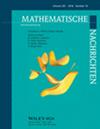求助PDF
{"title":"齐次型空间上的变Hardy空间及其在Lipschitz域上具有Robin边界条件的椭圆算子的变Hardy空间中的应用","authors":"Xiong Liu, Wenhua Wang","doi":"10.1002/mana.202400300","DOIUrl":null,"url":null,"abstract":"<p>Let <span></span><math>\n <semantics>\n <mrow>\n <mo>(</mo>\n <mi>X</mi>\n <mo>,</mo>\n <mi>d</mi>\n <mo>,</mo>\n <mi>μ</mi>\n <mo>)</mo>\n </mrow>\n <annotation>$(\\mathcal {X},d,\\mu)$</annotation>\n </semantics></math> be a space of homogeneous type with <span></span><math>\n <semantics>\n <mrow>\n <mi>μ</mi>\n <mo>(</mo>\n <mi>X</mi>\n <mo>)</mo>\n <mo><</mo>\n <mi>∞</mi>\n </mrow>\n <annotation>$\\mu (\\mathcal {X})<\\infty$</annotation>\n </semantics></math> and <span></span><math>\n <semantics>\n <mrow>\n <mi>p</mi>\n <mo>(</mo>\n <mo>·</mo>\n <mo>)</mo>\n <mo>:</mo>\n <mi>X</mi>\n <mo>→</mo>\n <mo>(</mo>\n <mn>0</mn>\n <mo>,</mo>\n <mi>∞</mi>\n <mo>)</mo>\n </mrow>\n <annotation>$p(\\cdot):\\mathcal {X}\\rightarrow (0,\\infty)$</annotation>\n </semantics></math> a variable exponent function satisfying <span></span><math>\n <semantics>\n <mrow>\n <mn>0</mn>\n <mo><</mo>\n <msub>\n <mi>p</mi>\n <mo>−</mo>\n </msub>\n <mo><</mo>\n <mi>∞</mi>\n </mrow>\n <annotation>$0<p_-<\\infty$</annotation>\n </semantics></math>, where <span></span><math>\n <semantics>\n <mrow>\n <msub>\n <mi>p</mi>\n <mo>−</mo>\n </msub>\n <mo>:</mo>\n <mo>=</mo>\n <mi>ess</mi>\n <mspace></mspace>\n <msub>\n <mi>inf</mi>\n <mrow>\n <mi>x</mi>\n <mo>∈</mo>\n <mi>X</mi>\n </mrow>\n </msub>\n <mi>p</mi>\n <mrow>\n <mo>(</mo>\n <mi>x</mi>\n <mo>)</mo>\n </mrow>\n </mrow>\n <annotation>$p_-:=\\mathrm{ess\\ inf}_{x\\in \\mathcal {X}}p(x)$</annotation>\n </semantics></math>. Assume that <span></span><math>\n <semantics>\n <mi>L</mi>\n <annotation>$L$</annotation>\n </semantics></math> is a nonnegative self-adjoint operator on <span></span><math>\n <semantics>\n <mrow>\n <msup>\n <mi>L</mi>\n <mn>2</mn>\n </msup>\n <mrow>\n <mo>(</mo>\n <mi>X</mi>\n <mo>)</mo>\n </mrow>\n </mrow>\n <annotation>$L^2(\\mathcal {X})$</annotation>\n </semantics></math> whose heat kernels satisfy the Gaussian upper bound estimates. In this paper, the authors first establish the atomic, nontangential, and radial maximal function characterizations for the variable Hardy space <span></span><math>\n <semantics>\n <mrow>\n <msubsup>\n <mi>H</mi>\n <mi>L</mi>\n <mrow>\n <mi>p</mi>\n <mo>(</mo>\n <mo>·</mo>\n <mo>)</mo>\n </mrow>\n </msubsup>\n <mrow>\n <mo>(</mo>\n <mi>X</mi>\n <mo>)</mo>\n </mrow>\n </mrow>\n <annotation>$H^{p(\\cdot)}_{L}(\\mathcal {X})$</annotation>\n </semantics></math> associated with <span></span><math>\n <semantics>\n <mi>L</mi>\n <annotation>$L$</annotation>\n </semantics></math>. Second, as applications, when <span></span><math>\n <semantics>\n <mrow>\n <mi>n</mi>\n <mo>≥</mo>\n <mn>2</mn>\n </mrow>\n <annotation>$n\\ge 2$</annotation>\n </semantics></math>, <span></span><math>\n <semantics>\n <mrow>\n <mi>Ω</mi>\n <mo>⊂</mo>\n <msup>\n <mi>R</mi>\n <mi>n</mi>\n </msup>\n </mrow>\n <annotation>$\\Omega \\subset \\mathbb {R}^n$</annotation>\n </semantics></math> is a bounded Lipschitz domain, <span></span><math>\n <semantics>\n <msub>\n <mi>L</mi>\n <mi>R</mi>\n </msub>\n <annotation>$L_R$</annotation>\n </semantics></math> is a second-order divergence form elliptic operator with the Robin boundary condition, the authors establish a new atomic characterization of the <span></span><math>\n <semantics>\n <mrow>\n <msubsup>\n <mi>H</mi>\n <msub>\n <mi>L</mi>\n <mi>R</mi>\n </msub>\n <mrow>\n <mi>p</mi>\n <mo>(</mo>\n <mo>·</mo>\n <mo>)</mo>\n </mrow>\n </msubsup>\n <mrow>\n <mo>(</mo>\n <mi>Ω</mi>\n <mo>)</mo>\n </mrow>\n </mrow>\n <annotation>$H^{p(\\cdot)}_{L_R}(\\Omega)$</annotation>\n </semantics></math> associated with <span></span><math>\n <semantics>\n <msub>\n <mi>L</mi>\n <mi>R</mi>\n </msub>\n <annotation>$L_R$</annotation>\n </semantics></math>, and then the authors further show that, for <span></span><math>\n <semantics>\n <mrow>\n <msub>\n <mi>p</mi>\n <mo>−</mo>\n </msub>\n <mo>∈</mo>\n <mrow>\n <mo>(</mo>\n <mfrac>\n <mi>n</mi>\n <mrow>\n <mi>n</mi>\n <mo>+</mo>\n <msub>\n <mi>δ</mi>\n <mn>0</mn>\n </msub>\n </mrow>\n </mfrac>\n <mo>,</mo>\n <mn>1</mn>\n <mo>]</mo>\n </mrow>\n </mrow>\n <annotation>$p_-\\in (\\frac{n}{n+\\delta _0},1]$</annotation>\n </semantics></math>,\n\n </p>","PeriodicalId":49853,"journal":{"name":"Mathematische Nachrichten","volume":"298 4","pages":"1370-1440"},"PeriodicalIF":0.8000,"publicationDate":"2025-02-27","publicationTypes":"Journal Article","fieldsOfStudy":null,"isOpenAccess":false,"openAccessPdf":"","citationCount":"0","resultStr":"{\"title\":\"Variable Hardy spaces on spaces of homogeneous type and applications to variable Hardy spaces associated with elliptic operators having Robin boundary conditions on Lipschitz domains\",\"authors\":\"Xiong Liu, Wenhua Wang\",\"doi\":\"10.1002/mana.202400300\",\"DOIUrl\":null,\"url\":null,\"abstract\":\"<p>Let <span></span><math>\\n <semantics>\\n <mrow>\\n <mo>(</mo>\\n <mi>X</mi>\\n <mo>,</mo>\\n <mi>d</mi>\\n <mo>,</mo>\\n <mi>μ</mi>\\n <mo>)</mo>\\n </mrow>\\n <annotation>$(\\\\mathcal {X},d,\\\\mu)$</annotation>\\n </semantics></math> be a space of homogeneous type with <span></span><math>\\n <semantics>\\n <mrow>\\n <mi>μ</mi>\\n <mo>(</mo>\\n <mi>X</mi>\\n <mo>)</mo>\\n <mo><</mo>\\n <mi>∞</mi>\\n </mrow>\\n <annotation>$\\\\mu (\\\\mathcal {X})<\\\\infty$</annotation>\\n </semantics></math> and <span></span><math>\\n <semantics>\\n <mrow>\\n <mi>p</mi>\\n <mo>(</mo>\\n <mo>·</mo>\\n <mo>)</mo>\\n <mo>:</mo>\\n <mi>X</mi>\\n <mo>→</mo>\\n <mo>(</mo>\\n <mn>0</mn>\\n <mo>,</mo>\\n <mi>∞</mi>\\n <mo>)</mo>\\n </mrow>\\n <annotation>$p(\\\\cdot):\\\\mathcal {X}\\\\rightarrow (0,\\\\infty)$</annotation>\\n </semantics></math> a variable exponent function satisfying <span></span><math>\\n <semantics>\\n <mrow>\\n <mn>0</mn>\\n <mo><</mo>\\n <msub>\\n <mi>p</mi>\\n <mo>−</mo>\\n </msub>\\n <mo><</mo>\\n <mi>∞</mi>\\n </mrow>\\n <annotation>$0<p_-<\\\\infty$</annotation>\\n </semantics></math>, where <span></span><math>\\n <semantics>\\n <mrow>\\n <msub>\\n <mi>p</mi>\\n <mo>−</mo>\\n </msub>\\n <mo>:</mo>\\n <mo>=</mo>\\n <mi>ess</mi>\\n <mspace></mspace>\\n <msub>\\n <mi>inf</mi>\\n <mrow>\\n <mi>x</mi>\\n <mo>∈</mo>\\n <mi>X</mi>\\n </mrow>\\n </msub>\\n <mi>p</mi>\\n <mrow>\\n <mo>(</mo>\\n <mi>x</mi>\\n <mo>)</mo>\\n </mrow>\\n </mrow>\\n <annotation>$p_-:=\\\\mathrm{ess\\\\ inf}_{x\\\\in \\\\mathcal {X}}p(x)$</annotation>\\n </semantics></math>. Assume that <span></span><math>\\n <semantics>\\n <mi>L</mi>\\n <annotation>$L$</annotation>\\n </semantics></math> is a nonnegative self-adjoint operator on <span></span><math>\\n <semantics>\\n <mrow>\\n <msup>\\n <mi>L</mi>\\n <mn>2</mn>\\n </msup>\\n <mrow>\\n <mo>(</mo>\\n <mi>X</mi>\\n <mo>)</mo>\\n </mrow>\\n </mrow>\\n <annotation>$L^2(\\\\mathcal {X})$</annotation>\\n </semantics></math> whose heat kernels satisfy the Gaussian upper bound estimates. In this paper, the authors first establish the atomic, nontangential, and radial maximal function characterizations for the variable Hardy space <span></span><math>\\n <semantics>\\n <mrow>\\n <msubsup>\\n <mi>H</mi>\\n <mi>L</mi>\\n <mrow>\\n <mi>p</mi>\\n <mo>(</mo>\\n <mo>·</mo>\\n <mo>)</mo>\\n </mrow>\\n </msubsup>\\n <mrow>\\n <mo>(</mo>\\n <mi>X</mi>\\n <mo>)</mo>\\n </mrow>\\n </mrow>\\n <annotation>$H^{p(\\\\cdot)}_{L}(\\\\mathcal {X})$</annotation>\\n </semantics></math> associated with <span></span><math>\\n <semantics>\\n <mi>L</mi>\\n <annotation>$L$</annotation>\\n </semantics></math>. Second, as applications, when <span></span><math>\\n <semantics>\\n <mrow>\\n <mi>n</mi>\\n <mo>≥</mo>\\n <mn>2</mn>\\n </mrow>\\n <annotation>$n\\\\ge 2$</annotation>\\n </semantics></math>, <span></span><math>\\n <semantics>\\n <mrow>\\n <mi>Ω</mi>\\n <mo>⊂</mo>\\n <msup>\\n <mi>R</mi>\\n <mi>n</mi>\\n </msup>\\n </mrow>\\n <annotation>$\\\\Omega \\\\subset \\\\mathbb {R}^n$</annotation>\\n </semantics></math> is a bounded Lipschitz domain, <span></span><math>\\n <semantics>\\n <msub>\\n <mi>L</mi>\\n <mi>R</mi>\\n </msub>\\n <annotation>$L_R$</annotation>\\n </semantics></math> is a second-order divergence form elliptic operator with the Robin boundary condition, the authors establish a new atomic characterization of the <span></span><math>\\n <semantics>\\n <mrow>\\n <msubsup>\\n <mi>H</mi>\\n <msub>\\n <mi>L</mi>\\n <mi>R</mi>\\n </msub>\\n <mrow>\\n <mi>p</mi>\\n <mo>(</mo>\\n <mo>·</mo>\\n <mo>)</mo>\\n </mrow>\\n </msubsup>\\n <mrow>\\n <mo>(</mo>\\n <mi>Ω</mi>\\n <mo>)</mo>\\n </mrow>\\n </mrow>\\n <annotation>$H^{p(\\\\cdot)}_{L_R}(\\\\Omega)$</annotation>\\n </semantics></math> associated with <span></span><math>\\n <semantics>\\n <msub>\\n <mi>L</mi>\\n <mi>R</mi>\\n </msub>\\n <annotation>$L_R$</annotation>\\n </semantics></math>, and then the authors further show that, for <span></span><math>\\n <semantics>\\n <mrow>\\n <msub>\\n <mi>p</mi>\\n <mo>−</mo>\\n </msub>\\n <mo>∈</mo>\\n <mrow>\\n <mo>(</mo>\\n <mfrac>\\n <mi>n</mi>\\n <mrow>\\n <mi>n</mi>\\n <mo>+</mo>\\n <msub>\\n <mi>δ</mi>\\n <mn>0</mn>\\n </msub>\\n </mrow>\\n </mfrac>\\n <mo>,</mo>\\n <mn>1</mn>\\n <mo>]</mo>\\n </mrow>\\n </mrow>\\n <annotation>$p_-\\\\in (\\\\frac{n}{n+\\\\delta _0},1]$</annotation>\\n </semantics></math>,\\n\\n </p>\",\"PeriodicalId\":49853,\"journal\":{\"name\":\"Mathematische Nachrichten\",\"volume\":\"298 4\",\"pages\":\"1370-1440\"},\"PeriodicalIF\":0.8000,\"publicationDate\":\"2025-02-27\",\"publicationTypes\":\"Journal Article\",\"fieldsOfStudy\":null,\"isOpenAccess\":false,\"openAccessPdf\":\"\",\"citationCount\":\"0\",\"resultStr\":null,\"platform\":\"Semanticscholar\",\"paperid\":null,\"PeriodicalName\":\"Mathematische Nachrichten\",\"FirstCategoryId\":\"100\",\"ListUrlMain\":\"https://onlinelibrary.wiley.com/doi/10.1002/mana.202400300\",\"RegionNum\":3,\"RegionCategory\":\"数学\",\"ArticlePicture\":[],\"TitleCN\":null,\"AbstractTextCN\":null,\"PMCID\":null,\"EPubDate\":\"\",\"PubModel\":\"\",\"JCR\":\"Q2\",\"JCRName\":\"MATHEMATICS\",\"Score\":null,\"Total\":0}","platform":"Semanticscholar","paperid":null,"PeriodicalName":"Mathematische Nachrichten","FirstCategoryId":"100","ListUrlMain":"https://onlinelibrary.wiley.com/doi/10.1002/mana.202400300","RegionNum":3,"RegionCategory":"数学","ArticlePicture":[],"TitleCN":null,"AbstractTextCN":null,"PMCID":null,"EPubDate":"","PubModel":"","JCR":"Q2","JCRName":"MATHEMATICS","Score":null,"Total":0}
引用次数: 0
引用
批量引用

 求助内容:
求助内容: 应助结果提醒方式:
应助结果提醒方式:


